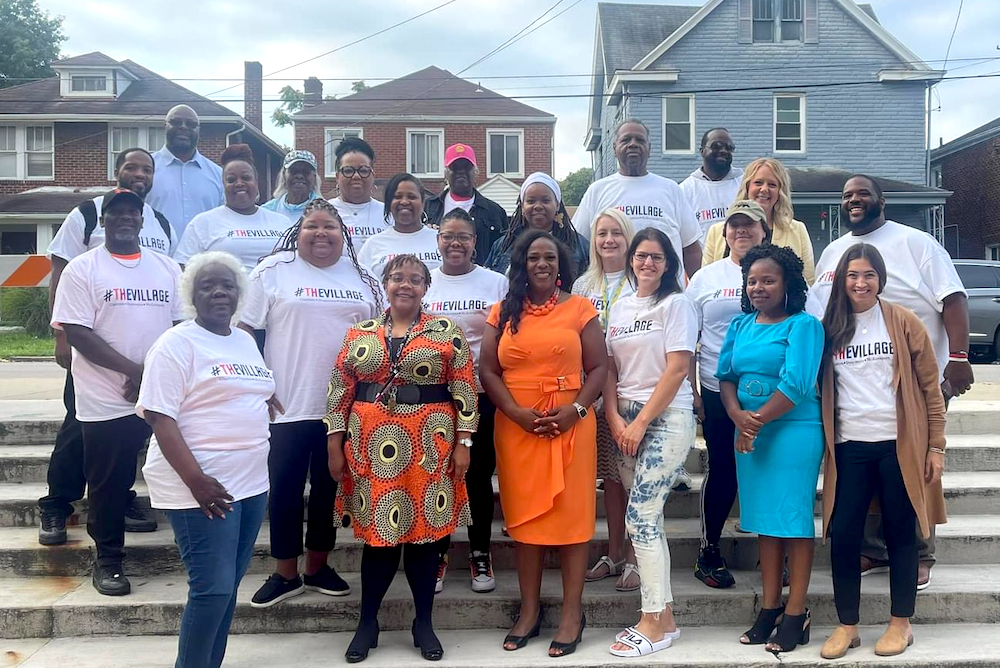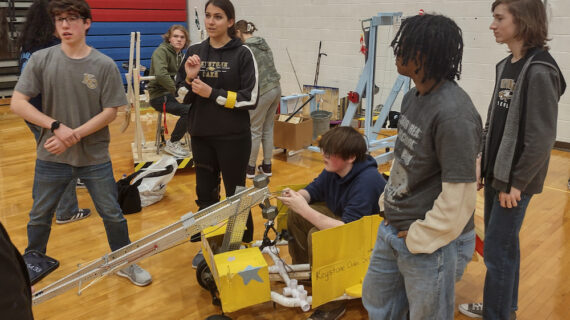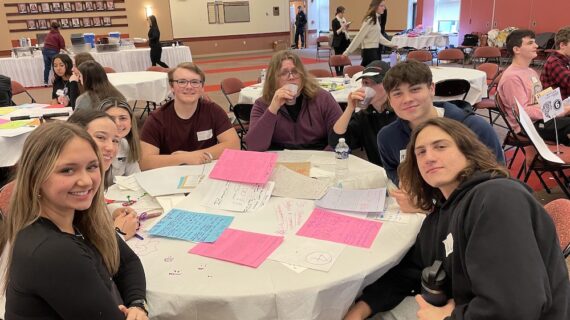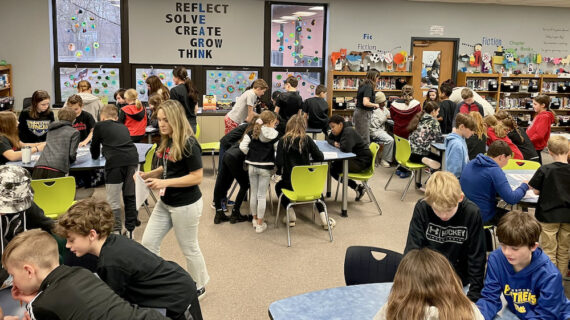
In the Clairton City School District, it takes a village — and the village shows up
This story is one in a series created in collaboration with the AASA Learning 2025 Alliance to celebrate the work of groundbreaking school districts in the Pittsburgh region. Kidsburgh will share these stories throughout 2024.
Everyone knows the old saying: “It takes a village to raise a child.”
It’s so ubiquitous, in fact, that scholars have struggled to pinpoint its origins. Some trace the adage’s roots to ancient African nations; others point to early Native Americans. Whatever its history, the phrase has endured through cultures and centuries, likely due to one simple fact: Anyone who’s raised a child knows the saying is true.
That’s why, once a month, a group of volunteers in the Clairton City School District gather at the doors of the district’s single building. They come from Clairton and the neighboring districts, knowing that in this part of Western Pennsylvania, kids and their families frequently move from one community to another.
They’re here, officials say, to greet the students arriving for the start of the school day.
“Our thought was, ‘Let’s give students some consistent people they see in their lives, even if they move a lot,’” says Tamara Allen-Thomas, Clairton City’s superintendent. “If we can help build and sustain those relationships, then we can help kids succeed — no matter where they happen to be.”
Fittingly, the volunteers call themselves The Village.

A collaborative effort among the Clairton City, Duquesne City, and McKeesport school districts, The Village offers more than a morning hello. It surrounds students with caring adults and mentors who’ve been in the students’ shoes.
“One of the biggest things we see is students beginning to recognize all of the talent and resources that the people in our communities bring,” says Sonia Ewell, dean of Clairton City’s elementary school and a Village volunteer herself. (Her husband, a local pastor, helped to bring the group together.) “The volunteers bring so much positivity. And students see not only that there are people here who support them — they also see who they might become.”
It’s the kind of collaboration that’s key to how Clairton City operates. The district partners with community organizations, health professionals, and others who provide meals and ensure students receive regular dentist visits. Graduates both recent and not-so-recent are a regular presence, serving as teachers, school board members, and volunteers. Even the district’s logo — the bold, orange ‘C’ emblazoned on the building’s entrances — was painted by an alum.
All of this is intentional, says Allen-Thomas. “Kids can’t see their future unless they see someone who looks like them succeeding in different fields. So we bring in as many role models as we can — people who sat in the same seats and ate in the same cafeteria. People who can share their struggles and say, ‘You know, I encountered these barriers, too. And look how I’ve succeeded.’”
The district’s belief in the power of a village led it to join the Western Pennsylvania Learning 2025 Alliance, a regional cohort of school districts working together — with support from The Grable Foundation — to create student-centered, equity-focused, future-driven schools. Led by local superintendents and AASA, The School Superintendents Association, the Alliance convenes to help districts like Clairton City do what they do best: prepare every learner for tomorrow.
“The networking and collaboration has been phenomenal,” says Allen-Thomas, noting that the Alliance’s cross-district opportunities for professional development — and extra funding available in the form of grants — have enabled Clairton City to expand its village even further.
Using a Tugboat Grant awarded by the Alliance, for example, the district has launched an art project involving students, staff, and the Clairton community at large. Working with renowned artist Laura Jean McLaughlin, they’re co-creating two mosaics for Clairton City’s building: one for the elementary school entrance and another for the entrance to the middle and high schools.
Each mosaic represents the district’s past, present, and future.
“We brought our former students in to talk about the district’s past,” Allen-Thomas explains. Meanwhile, “we have our current students articulating what the district is like today. And together, we’re envisioning the district’s tomorrow.”
Teachers have woven the effort into students’ STEAM classes, with ongoing, cross-generational planning sessions informing the mosaics’ design. Eventually, every student in the district will make and contribute at least one piece of the project, forming a collective statement about the district’s hopes and dreams.
For Debra Maurizio, Clairton City’s elementary school principal, the project has been one more way to bring the Village into the schools. “People come in and they share their passions with our students, whether those passions are art, music, or something else. And our students see adults taking time out of their day to be here with them. They see how much the community cares. It’s making more of an impact each and every month.”
And because the mosaics will be a permanent part of the district’s building, “they’ll stand the test of time,” she adds. “They’ll endure long past the end of a month or the end of a school year.”
In other words, they’ll endure just like the old adage.
“It takes a village, right? There’s so much that goes into raising and educating a child,” says Thomas McCloskey, Clairton City’s assistant superintendent. “And the pieces that go into making the mosaic, I think, are good metaphors for what we try to do here on a regular basis. They speak to something larger than the mosaics themselves. They represent all us here at Clairton City who — together — do whatever it takes to help our kids succeed.”
Want to download this story? Click here for a PDF.











